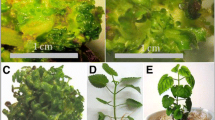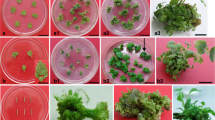Abstract
The first protocol for in vitro plant regeneration from different explants of Bituminaria bituminosa, a pasture and medicinal species, has been established. Three explant types (petiole, leaflet and petiole-leaflet attachment “PLA”) cultured on media with different combinations of benzylaminopurine (BA; 5.0, 10.0 or 20.0 μM) and naphthalene acetic acid (NAA) or indole acetic acid (IAA; 0.5 or 5.0 μM) were tested for calli induction, and with 5 μM BA + 0.5 μM NAA or IAA for shoot development. The average number of shoots (≥5 mm) per callus depended on the explant type and the calli induction medium. The highest average number of shoots per callus was achieved by culturing leaflet and PLA explants on 5 μM IAA + 10 μM BA for calli induction and on 0.5 μM IAA + 5 μM BA for shoot development, and by culturing petiole explants on 0.5 μM NAA + 10 μM BA followed by a second culture on 0.5 μM NAA + 5 μM BA. The highest frequency of shoot rooting was achieved with 10.0 μM NAA and 1.0 μM gibberellic acid (GA3). Rooted plants were acclimatised in a culture chamber, reaching 96 % survival. Acclimatised plants were transferred to a greenhouse and finally to the field, reaching 100 % survival. The furanocoumarin (FC) accumulation was evaluated in organogenic calli, in vitro shoots, ex vitro plants in the greenhouse and in ex vitro plants in the field (after 1 and 4 months of acclimatisation). The content of FCs depended on the plant material evaluated, being higher in ex vitro plants in the field (up to 9,824 μg g−1 DW total FC) and lowest in organogenic calli (up to 50 μg g−1 DW total FC). This effect may be due to cell organization, longer exposure to environmental factors and the developmental stage.


Similar content being viewed by others
Abbreviations
- BA:
-
6-benzylaminopurine
- NAA:
-
Naphthalene acetic acid
- IBA:
-
Indole-3-butyric acid
- IAA:
-
Indole-3-acetic acid
- GA3 :
-
Gibberellic acid
- PGR:
-
Plant Growth Regulator
- ½ MS medium:
-
Half strength of Murashige and Skoog (1962) mineral solution
- FC:
-
Furanocoumarin
- AC:
-
Activated charcoal
- DW:
-
Dry weight
- PLA:
-
Petiole-leaflet attachment
References
Ahmad N, Faisal M, Anis M, Aref IM (2010) In vitro callus induction and plant regeneration from leaf explants of Ruta graveolens. S Afr J Bot 76:597–600
Baskaran P, Jayabalan N (2009a) In vitro regeneration of Psoralea corylifolia L. through callus cultures. Plant Biotech 26:333–336
Baskaran P, Jayabalan N (2009b) An improve protocol for adventitious shoot regeneration and plant formation in Psoralea corylifolia L. Sci Hort 123:283–286
Baskaran P, Jayabalan N, Van Staden J (2011) Production of psoralen by in vitro regenerated plants from callus cultures of Psoralea corylifolia L. Plant Growth Regul 65:47–54
Berembaum M (1983) Coumarins and caterpillars: a case of evolution. Evolution 37:163–179
Bourgaud F, Hehn A, Larbat R, Doerper S, Gontier E, Kellner S, Matern U (2006) Biosynthesis of coumarins in plants: a major pathway still to be unravelled for cytochrome P450 enzymes. Phytochem Rev 5:293–308
Cheng S, Van Houten B, Gamper HB, Sancar A, Hearst JE (1988) Use os psoralen-modified oligonucleotides to trap three-stranded RecA-DNA complexes and repair of those cross-linked complexes by ABC exinuclease. J Biol Chem 263:15110–15117
Diwan R, Malpathak N (2010) Histochemical localization in Ruta graveolens cell cultures: elucidating the relationship between cellular differentiation and furanocoumarin production. In vitro Cell Dev Biol 46:108–116
Hamerski D, Matern U (1988) Elicitor-induced biosynthesis of psoralens in Ammi majus L. suspension cultures: microsomal conversion of demethylsuberosin into (+) marmesin and psoralen. Eur J Biochem 171:369–375
Hehmann M, Lukacin R, Ekiert H, Matern U (2004) Furanocoumarin biosynthesis in Ammi majus L. Cloning of bergaptol O-methyltransferase. Eur J Biochem 271:932–940
Martínez S, Correal E, Real D, Ortuño A, Del Río JA (2010) Bituminaria bituminosa: a source of furanocoumarins of pharmaceutical interest. In: Awaad AS, Govil JN, Singh VK (eds) Recent progress in medicinal plants (RPMP) vol 27 drug plants I. Studium Press, LLC, Texas, pp 307–322
Martínez-Fernández D, Walker DJ, Romero-Espinar P, Flores P, del Río JA (2011) Physiological responses of Bituminaria bituminosa to heavy metals. J Plant Physiol 168:2206–2211
Milesi S, Massot B, Gontier E, Bourgaud F, Guckert A (2001) Ruta graveolens L.: a promising species for the production of furanocoumarins. Plant Sci 161:189–199
Murashige T, Skoog F (1962) A revised medium for rapid growth and bio-assays with tobacco tissue cultures. Physiol Plant 15:473–497
Pande D, Purohit M, Srivastava PS (2002) Variation in xanthotoxin content in Ammi majus L. cultures during in vitro flowering and fruiting. Plant Sci 162:583–587
Pazos-Navarro M, Del Río JA, Ortuño A, Romero-Espinar P, Correal E, Dabauza M (2012) Micropropagation from apical and nodal segments of Bituminaria bituminosa and the furanocoumarin content of propagated plants. J Hort Sci Biotech 87:29–35
Raskin I, Ribnicky DM, Komarnytsky S, Ilic N, Poulev A, Borisjuk N, Brinker A, Moreno DA, Ripoll C, Yakoby N, O’Neal JM, Cornwell T, Pastor I, Fridlender B (2002) Plants and human health in the twenty-first century. Trends Biotech 20:522–531
Real D, Verbyla A (2010) Maximizing genetic gains using a “plant” model in the Tedera (Bituminaria bituminosa var. albomarginata and var. crassiuscula) breeding program in Australia. Options Méditerranéennes 92:87–96
Real D, Albersten T, Snowball R, Howieson J, Revell C, Ewing M, Correal E, Méndez P, Rios S (2008) Bituminaria bituminosa var. albomarginata (Lancelot trefoil), a novel perennial forage legume for low-rainfall Mediterranean environments in Western Australia. In: XXI international grassland congress and VIII international rangeland congress, vol II. Hohhot, P.R. China, p 452
Real D, Li GD, Clark S, Albertsen TO, Hayes RC, Denton MD, D’Antuono MF, Dear BS (2011) Evaluation of perennial forage legumes and herbs in six Mediterranean environments. Chil J Agric Res 71:367–369
Saxena C, Palai SK, Samantaray S, Rout GR, Das P (1997) Plant regeneration from callus of Psoralea corylifolia Linn. Plant Growth Regul 22:13–17
Soil Survey Staff (2010) Keys to soil taxonomy, 11th edn. USDA-Natural Resources Conservation Service, Washington
Tiejten KG, Hunkler D, Matern U (1983) Differential response of cultured parsley cells to elicitors from two non-pathogenic strains of fungi 1. Identification of induced products as coumarin derivatives. Eur J Biochem 131:401–407
Trumble JT, Dercks W, Quiros CF, Beier RC (1990) Host plant resistance and linear furanocoumarin content of Apium accessions. J Econ Entomol 83:519–525
Walker DJ, Moñino I, Correal E (2006) Genome size in Bituminaria bituminosa (L.) C.H. Stirton (Fabaceae) populations: separation of “true” differences from environmental effects on DNA determination. Environ Exp Bot 55:258–265
Walker DJ, Bernal MP, Correal E (2007) The influence of heavy metals and mineral nutrient supply on Bituminaria bituminosa. Water Air Soil Pollut 184:335–345
Walker DJ, Martínez-Fernández D, Correal E, Romero-Espinar P, del Río JA (2012) Accumulation of furanocoumarins by Bituminaria bituminosa in relation to plant development and environmental stress. Plant Physiol Biochem 54:133–139
Acknowledgments
We thank A. Palazón and V. Arnau for their collaboration and excellent technical assistance and Dr. Walker for his critical review of the manuscript. This research was supported by Instituto Nacional de Investigación y Tecnología Agraria y Alimentaria (RTA2007-00046-00-00), Ministerio de Ciencia e Innovación, (BFU2010-19599) and by a studentship provided by IMIDA to M. Pazos-Navarro. M. Dabauza was co-supported by the European Social Fund and IMIDA.
Author information
Authors and Affiliations
Corresponding author
Rights and permissions
About this article
Cite this article
Pazos-Navarro, M., Del Río, J.A., Ortuño, A. et al. Plant regeneration from different explant types of Bituminaria bituminosa and furanocoumarin content along plant regeneration stages. Plant Growth Regul 70, 123–129 (2013). https://doi.org/10.1007/s10725-013-9784-9
Received:
Accepted:
Published:
Issue Date:
DOI: https://doi.org/10.1007/s10725-013-9784-9




